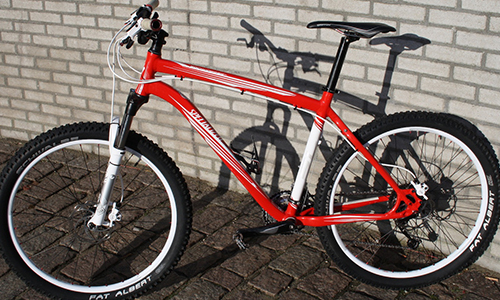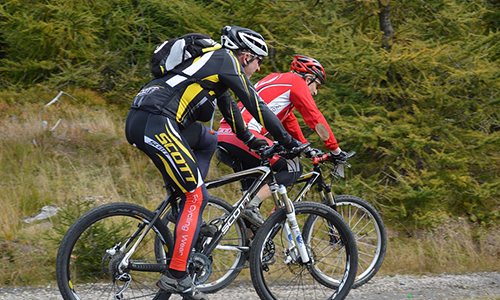5 Tips to Keep Your Mountain Bike Well-Maintained
Author

A keen runner, skier and nuts about cycling. Karl lives in Cumbria, where he loves encouraging his two children to follow in his outdoor lifestyle. Whilst out and about keeping active, Karl keeps a diary and shares it with Outdoor Look.
 Keeping your mountain bike well maintained is not only important for its lifespan, but more importantly, your safety. Its timely service will help prevent untimely corrosion of parts and components.
Keeping your mountain bike well maintained is not only important for its lifespan, but more importantly, your safety. Its timely service will help prevent untimely corrosion of parts and components.
From checking tire pressure to bleeding the brakes and suspension, the below mentioned tips will help ensure a consistent performance of your mountain bike without compromising your safety:
Regular Cleaning
Dirt and grime can corrode the body of the bike which is why it is important that you clean up your bike properly once a week. If possible, try and remove the mud and grime on the same day and carry out a thorough clean-up once a week. Make sure that you use bike cleaner to prevent damaging the moving parts or finishing in the frame. Check for any rubbing, loose or clicking parts along with any cracks on the frame or wheels, after you are done cleaning the bike.
Hubs, Cranks and Headset
 Make sure the hubs are tight, clean and greased properly as they directly affect the wheels. Adjust the cranks accordingly so that the chain does not get strained while paddling. If the cranks shift around or click, then it is important that you service then thoroughly. Grease the headsets and tighten them up according to your convenience and safety requirements.
Make sure the hubs are tight, clean and greased properly as they directly affect the wheels. Adjust the cranks accordingly so that the chain does not get strained while paddling. If the cranks shift around or click, then it is important that you service then thoroughly. Grease the headsets and tighten them up according to your convenience and safety requirements.
Brakes
Mountain bikes with disc brakes or calipers need to be serviced on a regular basis so that you can stop when you need to while riding. Check if the rotor of the disc brake is warped. A warped rotor makes it difficult to apply the brake. Get a bleed kit to prevent rotor contamination. Check the bleed adaptors and fitting. Refill the brake fluid if required. For caliper brakes, you need to check the pad of the brake in order to detect any wear and tear. Spin the wheel by lifting it slightly up in the air to check whether the brake stops the moving wheel and if there is any obstruction caused to the wheel when the brake is not pressured. Unscrew the worn out brake pads and replace them with the new ones if you find that the existing pads are not stopping the wheel properly. For the disc brakes, the replacement should be done when they are less than 1mm thick.
Mechanical brakes including the calipers use cables to operate and therefore necessary precautions are required to keep the cables working in perfect condition. When servicing the brakes, make sure to check the cables too. Sluggishness while applying the brake calls fall the change of the cables. Similarly, bleeding the disc brakes can prevent faulty breaking.
Shifter Cables and Cassettes
Damaged and finicky shifter cables will not move the chain up and down the gears with the required swiftness and precision. Therefore, they should be replaced with the new ones. Make adjustments to the derailleur and keep it in line with the gears. Cassettes of a bicycle need a change when they have sprocket edges, causing the gears to shift poorly. Only some lubrication can solve the matter, but in the case of worn out parts, it is necessary that you replace the cassette with a new one.
Tires and Wheels
Make sure that the tires run properly, without touching or rubbing any component of the bike. The same thing goes for the wheels. Check for any broken spokes, worn-out hubs, or rim damage.
Any cuts or tears on the tires invite for replacement. Check whether there are potential puncture causing elements stuck in the tire or not. Worn out tyres should be immediately replaced.
Author

A keen runner, skier and nuts about cycling. Karl lives in Cumbria, where he loves encouraging his two children to follow in his outdoor lifestyle. Whilst out and about keeping active, Karl keeps a diary and shares it with Outdoor Look.
Categories
- Sport (28)
- Product Reviews (3)
- Team Outdoor Look (7)
- Mike Wild (2)
- Mike Payton (2)
- Suse Hammond-Pears (3)
- Snowboarding (12)
- Latest Offers (105)
- Shop Talk (1)
- Competitions (7)
- Walking (413)
- Lifestyle Fashion (8)
- Travel (86)
- Kit Guides (176)
- Workwear Clothing (6)
- Safety Workwear (4)
- Health/Fitness (289)
- Skiing (91)
- Great Outdoors (1316)
- Cycling (92)
- January 2025
- December 2024
- November 2024
- October 2024
- September 2024
- August 2024
- July 2024
- June 2024
- May 2024
- April 2024
- March 2024
- February 2024
- January 2024
- December 2023
- November 2023
- October 2023
- September 2023
- August 2023
- July 2023
- June 2023
- May 2023
- April 2023
- March 2023
- February 2023
- January 2023
- December 2022
- November 2022
- October 2022
- September 2022
- August 2022
- July 2022
- June 2022
- May 2022
- April 2022
- March 2022
- February 2022
- January 2022
- December 2021
- November 2021
- October 2021
- September 2021
- August 2021
- July 2021
- June 2021
- May 2021
- April 2021
- March 2021
- February 2021
- January 2021
- December 2020
- November 2020
- October 2020
- September 2020
- August 2020
- July 2020
- June 2020
- May 2020
- April 2020
- March 2020
- February 2020
- January 2020
- December 2019
- November 2019
- October 2019
- September 2019
- August 2019
- July 2019
- June 2019
- May 2019
- April 2019
- March 2019
- February 2019
- January 2019
- December 2018
- November 2018
- October 2018
- September 2018
- August 2018
- July 2018
- June 2018
- May 2018
- April 2018
- March 2018
- February 2018
- January 2018
- December 2017
- November 2017
- October 2017
- September 2017
- August 2017
- July 2017
- June 2017
- May 2017
- April 2017
- March 2017
- February 2017
- January 2017
- December 2016
- November 2016
- October 2016
- September 2016
- August 2016
- July 2016
- June 2016
- May 2016
- April 2016
- March 2016
- February 2016
- January 2016
- December 2015
- November 2015
- October 2015
- September 2015
- August 2015
- July 2015
- June 2015
- May 2015
- April 2015
- March 2015
- February 2015
- January 2015
- December 2014
- November 2014
- October 2014
- September 2014
- August 2014
- July 2014
- June 2014
- May 2014
- April 2014
- March 2014
- February 2014
- January 2014
- December 2013
- November 2013
- October 2013
- September 2013
- August 2013
- July 2013
- June 2013
- May 2013
- April 2013
- March 2013
- February 2013
- January 2013
- December 2012
- November 2012
- October 2012
- September 2012
- August 2012
- July 2012
- June 2012
- May 2012
- April 2012
- March 2012
- February 2012
- January 2012
- December 2011
- November 2011
- October 2011
- September 2011
- August 2011
- May 2010
- April 2010
- March 2010
- February 2010
- January 2010
- November 2009
- October 2009
- September 2009
Submit a Comment